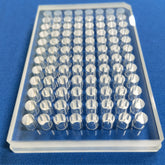Precautions and maintenance of quartz glass tubes in heating furnaces
29 Aug 2024
0 Comments
- The softening point of the quartz tube is1270 degrees Celsius. Furthermore, the tube should not be employed continuously for periods exceeding three hours at temperatures exceeding 1200 degrees Celsius.
- It is imperative to maintain the furnace tube in a clean and hygienic state, ensuring that no substances capable of reacting with SiO2 are permitted to remain on the furnace tube. In order to extend the operational lifespan of the furnace tube, it is essential to employ the use of a quartz boat as a carrier for the materialsduring their combustion.
- It is of the utmost importance that the ceramic plugs are placed when heating the furnace tube. In the absence of the aforementioned ceramic plugs, the temperature at both ends of the furnace tube will be higher than optimal. This will result in the O-ring in the flange being unable to withstand the increased temperature, leading to a reduction in the air tightness of the furnace. Placing furnace plugs at both ends of the furnace tube facilitates the formation of a balanced temperature field.

- The quartz tube is equipped with heavysealing flange made of stainless steel at both ends. When operating at elevated temperatures exceeding 1100 degrees Celsius, it is imperative to provide support for the two ends of the flange to prevent deformation of the quartz tube, as it is unable to withstand the weight of the flange.
- The temperature resistance of a quartz tube is dependent upon its purity, with higher purity resulting in highertemperature resistance.
- Although quartz glass exhibits excellent resistance to rapid heat, its use with other substances necessitates consideration of the expansion coefficient of these substances, otherwise it will cause damage.
- When there are remaining test samples in the quartz tube, they should be meticulously cleaned using ionized water or alcohol scrubbing. Following cleaning, direct contact with hands and dust contaminationmust be strictly avoided, as this could compromise the high purity of the glass and impact its service life.

- Under normal circumstances, it is not advisable to introduce hydrogen into tubular furnaces unless its concentration falls within the explosion limit. If it becomes necessary to pass hydrogen with a concentration above the explosion limit through a tube furnace, appropriate safety measures must be implemented. It is important not to stand at either end of the furnace tube when passing hydrogen. When passing hydrogen, stainless steel tubing should be used due to its higher thermal conductivity compared to quartz; both ends of stainless steel tubing require water cooling to prevent excessive O-ring temperatures that may affect sealing.
Tags:






